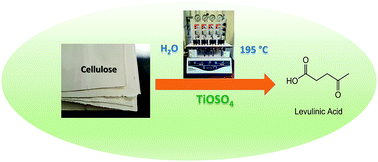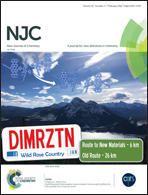Exploring and exploiting different catalytic systems for the direct conversion of cellulose into levulinic acid†
Abstract
The conversion of cellulose into target chemicals is essential for the development of the sustainable chemical industry of the future. To this end, the single step transformation of cellulose into levulinic acid (LA) has been investigated in different aqueous systems and using either Brønsted acidic ILs, metal salts, or a mixture of these as catalysts with or without the formation of carbonic acid in situ. The effect of varying the reaction parameters, such as temperature, time, substrate concentration, and catalyst loading, on conversion and selectivity has been studied. A few different systems [(TMGH)(HSO4)–FeCl3 or (TMGH)(HSO4)–CrCl3 in H2O–CO2, (TMGH)(HSO4)–CrCl3 in H2O, FeCl3 in H2O, and FeCl3 or CrCl3 in H2O–CO2] allowed for the isolation of LA in good yields (41–55 mol%). The best and remarkably high yield of LA (69 mol%) has been obtained in water at 195 °C (4 h) by using TiOSO4 (0.375 wt%) as a catalyst. This new, environmentally friendly catalytic system retains high activity after five consecutive runs. Its catalytic activity has been discussed taking into account the hydrolysis process occurring under the reaction conditions.



 Please wait while we load your content...
Please wait while we load your content...